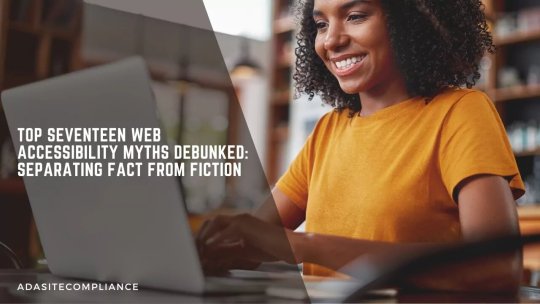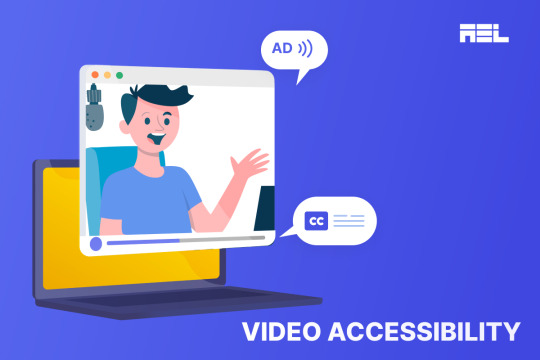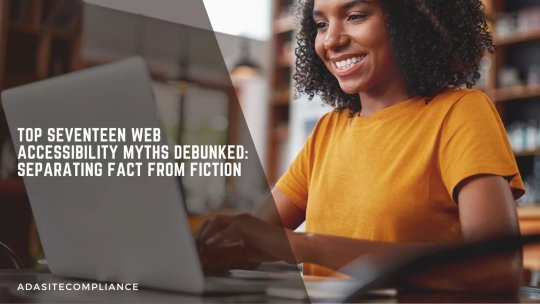#ada web compliance
Explore tagged Tumblr posts
Text
Why is ADA compliance important?
Read Here:-https://qr.ae/pykU5O
#ADA Compliant Website Services#ADA compliant website development#ADA Compliant Website Design Services#ada web compliance
0 notes
Text
Web Accessibility Widget – Seamless ADA & WCAG Compliance by WebAbility
WebAbility’s Web Accessibility Widget offers a powerful, user-friendly solution to make your website accessible and compliant with ADA and WCAG 2.1 guidelines. It includes essential tools like screen reader support, text resizing, contrast adjustments, and keyboard navigation—ensuring your site is usable by all visitors. The widget installs in minutes, requires no coding, and works across all platforms. Whether you're a small business or enterprise, WebAbility provides an affordable, customizable way to enhance accessibility and user experience.
#Affordable Accessibility Solutions#Web Accessibility Widget#WCAG Compliance#Affordable ADA Compliance#ADA Website Widget#ADA Compliance Tool#Accessibility Compliance Statement
1 note
·
View note
Text
Affordable Accessibility Solutions by WebAbility – Compliance Made Easy
WebAbility offers affordable accessibility solutions that help your website meet ADA and WCAG compliance without high costs or complexity. Our accessibility widget provides essential features like screen reader compatibility, font scaling, contrast adjustments, and keyboard navigation. It’s quick to install, fully customizable, and perfect for businesses of all sizes. With WebAbility, making your site inclusive, user-friendly, and legally compliant is simple, effective, and budget-friendly.
#Web Accessibility Widget#Affordable Accessibility Solutions#WCAG Compliance#Affordable ADA Compliance#ADA Website Widget#ADA Compliance Tool#Accessibility Compliance Statement#Rapid Integration Accessibility#website accessibility checker accessibe#ada compliance accessibe#accessibe
0 notes
Text

Accessibility Benefits For Businesses
ADA Site Compliance shows the benefits of accessibility for businesses!
#Web Accessibility Myths#Digital Accessibility#ADA Compliance#WCAG Compliance#Inclusive Web Design#Accessibility Testing Tools#Assistive Technologies#Accessible Website Design#Web Compliance#Accessibility Guidelines#Accessibility Misconceptions#Keyboard Navigation#Alt Text for Images#Accessibility Overlays#Color Contrast#website accessibility solutions#ADA site compliance#ADASiteCompliance#adasitecompliance.com
1 note
·
View note
Text
Trusted ADA Compliant Web Design Services by Netlynx Inc

Netlynx Inc offers an ADA Compliant Web Design Agency that enables users with disabilities to access your website.What we do is mainly concerned with developing ADA compliant web pages that have both functional and aesthetic value. With our help, your company can satisfy all the requirements of ADA and provide a pleasant experience to every visitor. Go for Netlynx Inc for consistent web designing which meets your accessibility needs.
0 notes
Text
Improving Website Accessibility for Small Businesses
Did you know that about 16% of people worldwide have a permanent disability1? This fact shows how crucial it is for small businesses to make their websites accessible to everyone. In fact, 70% of shoppers want brands to take action on social issues, including making websites easy for people with disabilities1. More than 90% of people don’t complain about website issues, but 69% with disabilities…
#Accessible Web Development#ADA Compliance#Digital Accessibility#Inclusive Website Design#SEO for Small Businesses#Small Business Websites#User-Friendly Websites#Web Accessibility#Web Accessibility Tools#Website Design Best Practices
0 notes
Text
Guide to Creating ADA-Compliant Accessible Videos

Get essential tips in our guide to creating ADA-compliant videos, ensuring accessibility for all viewers and enhancing user engagement.
0 notes
Text
Digital inaccessibility: Blind and low-vision people have powerful technology but still face barriers to the digital world.
Despite advances in assistive tech, the visually impaired face digital hurdles. Inaccessible websites & software limit job opportunities. Let's advocate for a fully accessible digital world. 🌍💼👁️ #DigitalInclusion #Accessibility #TechForAll #axschat
Screen reader software converts text to audio for people who are blind. Access Matters/Flickr, CC BY-NC-SA Michele McDonnall, Mississippi State University Imagine that you have low vision and you’re completing an online job application using screen reader software. You get through half the form and then come to a question with drop-down options the screen reader cannot access because the…

View On WordPress
#accessibility#Accessibility Challenges#ADA Compliance#Antonio Vieira Santos#Assistive Technology#Blindness#Digital Accessibility#digital inclusion#Employment Barriers#future of work#Low Vision#Screen Readers#Web Content Accessibility Guidelines
0 notes
Text
Does My Website Need To Be ADA-Compliant?

Does my website need to be ADA-compliant? Suppose you own a business or organization with a website and people visit your site in order to obtain information about or purchase your products or services. In that case, your site needs to comply with ADA regulations. Websites should be accessible to all individuals regardless of their ability or disability. The ADA is the principal civil rights statute for people with disabilities. Under Title III of the ADA, businesses and nonprofit service providers must make reasonable modifications in policies and procedures to permit access for all people, including those with disabilities.
In this guide, learn if your website needs to be ADA-compliant and what the ADA requires of your business.
Yes, it does.
The Americans with Disabilities Act (ADA) is a civil rights law that prohibits discrimination based on disability. It applies to all places of public accommodation, including websites that are part of those businesses.
Websites should be accessible to all individuals regardless of their ability or disability.
In the United States, the Americans with Disabilities Act (ADA) was signed into law in 1990, which requires all businesses and organizations to provide equal access to their goods and services. Websites should be no exception!
The ADA covers a wide range of conditions that may affect one’s ability to interact with others in various ways. These include: blindness/visual impairment; deafness/hard-of-hearing; autism spectrum disorder; cerebral palsy; diabetes; epilepsy or other seizure disorders; intellectual disability; learning disabilities and/or ADHD (attention deficit hyperactivity disorder); muscular dystrophy; multiple sclerosis or other degenerative brain diseases similar in nature; stroke, traumatic brain injury (TBI)/post-concussive syndrome.
The ADA is the principal civil rights statute for people with disabilities.
The ADA also prohibits discrimination based on disability in all programs, activities, and services offered by public entities. It applies to each of us – doctors, nurses, hospitals; restaurants and hotels; landlords who rent apartments or houses; theaters – any place we go to purchase something or do business.
However, what amounts to “reasonable” will vary from case to case. The law provides several factors for determining whether an accommodation is reasonable: best practices in the industry at issue; other relevant federal laws and regulations that require compliance with standards similar to or more stringent than those required by Title III (for example: Section 508); the resources available at that particular site; whether there are alternative ways of meeting both legitimate concerns raised by the organization as well as its legal obligations under Title III; what types of accommodations other customers without disabilities typically receive at that location or venue; how often customers without disabilities experience difficulties accessing such facilities due to structural barriers; whether making a change would be impracticable because it would produce significant economic hardship on small business owners who operate limited-service restaurants or retail stores catering primarily toward one sex or gender-based upon stereotypes about manners associated with certain genders (which might warrant a finding that allowing individuals into these locations would fundamentally alter their operations).
Legal action has already been taken against businesses where it was determined that their website was not compliant with ADA rules.
ADA compliance is not a suggestion, it’s a requirement. If you run any sort of business that has a physical presence, and if more than one person is present at that business, then ADA compliance applies to you.
This includes everything from the most basic retail store to your own website and digital presence. If you offer goods or services online (even if they’re free), then ADA compliance applies to your website as well.
The government has also made clear that they’re not just interested in large businesses when it comes to ADA rules—they want every business owner and operator on board. The law states: “The Americans with Disabilities Act requires all public entities…to ensure effective communication with individuals with disabilities.”
Web Content Accessibility Guidelines.
The Web Content Accessibility Guidelines (WCAG) 2.1 became effective on June 5, 2018. WCAG 2.1 builds upon WCAG 2.0 to ensure compliance with ADA regulations and laws by providing website owners with guidelines for ensuring that the content on their websites is accessible to all users, including those who have physical or mental disabilities. These include visual impairments (low vision, color blindness), hearing loss, physical limitations (mobility impairments), and cognitive limitations (dyslexia and language disorders).
The updated guidelines can be applied immediately when making changes to existing websites or content or planning new ones, even if a site hasn’t been built yet.
Conclusion
Keeping up with the latest web accessibility guidelines is important, but it’s not always easy. If you’re looking for ways to improve your website’s compliance with ADA standards or just want to ensure that it complies with other legal obligations, contact the experts at Reversed Out Creative today!
Contact Us
At Reversed Out Creative, we understand the challenges and opportunities presented by AI disruption. Our team of experts specializes in web design, SEO, graphic design, and digital marketing services. Reach out to us through our contact form to learn more about navigating the evolving job market and embracing the potential of AI. Together, let’s shape a future that combines human ingenuity with the power of AI.
Original content source: https://reversedout.com/does-my-website-need-to-be-ada-compliant/
#ADA compliance#Website accessibility#Accessibility standards#Web accessibility guidelines#Web accessibility best practices#The Americans with Disabilities Act
0 notes
Text
Unlock the full potential of your online presence with "Inclusive SEO Best Practices: Ensuring Web Accessibility for People with Disabilities." Learn how to create a digital space that welcomes everyone by implementing accessibility measures. This comprehensive guide covers strategies to enhance your website's usability, cater to diverse user needs, and boost overall inclusivity. Elevate your SEO game while making a positive impact on users of all abilities.
#Inclusive SEO#Web Accessibility#SEO for Disabilities#Accessible Website#Inclusive Design#Disability-friendly SEO#SEO and ADA Compliance#Web Inclusivity#Diverse User Experience#SEO for All
0 notes
Text
#ADA Compliant#Shopify#Shopify Website#Accessible Website#Web Accessibility#Web Accessibility Testing#eCommerce Website#Automate Web Accessibility#Accessibility Shopping#Accessibility Compliance#Image Accessibility
0 notes
Text
What does ADA compliant mean for websites?
Read Here :- https://qr.ae/pyA9Z4
#ADA Compliant Website Services#ADA compliant website development#ADA Compliant Website Design Services#ada web compliance
0 notes
Text
Know About The Importance of ADA Complaints for Websites
Unlock the essential insights on ADA compliance for websites in our latest blog post. Discover why Ada for Web stands at the forefront of ensuring inclusivity and accessibility. Delve into the details at Ada for Web and enhance your awareness of crafting an inclusive digital realm that caters to all users. Learn how prioritizing ADA compliance not only fosters equal access but also elevates the user experience, making your online presence more impactful and accessible.
0 notes
Text
ADA Compliance Tool for Inclusive and Legally Compliant Websites
WebAbility’s ADA Compliance Tool is designed to help websites meet the Americans with Disabilities Act (ADA) standards with ease and affordability. Featuring a user-friendly accessibility widget, it offers tools like screen reader compatibility, keyboard navigation, contrast controls, and text adjustments. No coding is required, and it integrates seamlessly into any website. Ideal for businesses of all sizes, this tool ensures your site is accessible, legally compliant, and welcoming to all users. Stay protected and promote inclusivity with WebAbility.
#Web Accessibility Widget#Affordable Accessibility Solutions#WCAG Compliance#Affordable ADA Compliance#ADA Website Widget#ADA Compliance Tool#Accessibility Compliance Statement#Rapid Integration Accessibility#website accessibility checker accessibe#ada compliance accessibe#accessibe
1 note
·
View note
Text
Accessible Website Design

Top Seventeen Web Accessibility Myths Debunked: Separating Fact from Fiction
Accessibility is no longer a ‘luxury’.
Incorporating accessibility into a website today comes part and parcel with web development. With the internet harboring users with and without disabilities who use it for information, bookings, enrollments, purchases, and even jobs, websites need to be compliant.
Unfortunately, many aren’t because some misconceptions and myths cause confusion and hesitance to hinder progress. So here’s an attempt at separating fact from fiction by debunking the top 17 common web accessibility myths.
Remember, web accessibility is no longer just a legal requirement; it’s part of digital inclusivity. It increases your reach and demonstrates your commitment to serving everyone in your community.
If achieving compliance seems overwhelming, we at ADA Site Compliance can simplify things for you. Our team of accessibility experts can help you meet these requirements while you focus on your core business.
Top 17 Web Accessibility Myths Debunked
Let’s now examine these widely misinterpreted web content accessibility principles and guidelines. At the end of the article, you will realize that all those misconceptions you had about web compliance are just myths.
Myth #1- Web Accessibility is Only for Blind People and Users with Visual Impairments
False.
Other people with varied disabilities, such as deafness, limited motor skills, and cognitive limitations, also visit websites for various reasons. An accessible website gives them access to the information they seek, ensuring your website reaches more people.
Myth #2- Web Content Accessibility Guidelines Compliance Ensures Digital Accessibility
False.
Yes, the WCAG provides a framework to enhance digital accessibility. However, compliance alone is not enough for a completely accessible website. Website owners and developers must understand and implement the WCAG principles, as factors like cumbersome user interfaces, poor content, and insufficient testing can lead to incompliant websites.
Myth #3- Accessibility is Only About Making Websites Accessible
False.
Accessibility applies to other digital assets, including mobile applications, PDFs, and other digital documents. Organizations must thus ensure accessibility across all digital platforms for inclusive digital experiences.
Myth #4- Accessibility is Only Relevant for Disabled People
False.
It is not just people with disabilities that benefit from website accessibility. Digital compliance features benefits extend to broader groups, including:
Older adults facing sensory or cognitive challenges as they age
Individuals with temporary disabilities due to injury, illness, or surgery
People experiencing situational limitations, like background noise
Non-native speakers struggling with language barriers hindering understanding and engagement
Myth #5- Accessibility Means Redesigning a Less Visually Appealing Website
False.
Many businesses believe digital accessibility requires a complete website overhaul or poor visual appeal, which is far from the truth. Minor adjustments can significantly create an accessible digital experience without significant redesign efforts.
Myth #6- Digital Accessibility is Only a Concern for Large Corporations
False.
Size is not a criterion for digital accessibility; failure to meet the many digital accessibility laws can lead to legal repercussions and damage a company’s reputation.
Small businesses may face resource constraints, but the numerous tools and online resources can help them understand and ensure web compliance. Embedding accessibility practices from the start ensures web compliance for companies of all sizes.
Myth #7- Accessibility Limits Websites to Text-Only Content
False.
The myth that accessible websites must be plain, text-heavy, and free of multimedia elements stems from earlier text-based web pages. However, modern standards allow visually engaging, multimedia-rich websites that meet diverse accessibility needs.
Strategies like adding alt text for images and captions and transcripts to videos ensure compatibility with assistive technologies. It not only supports users with disabilities but also enhances everyone’s user experience.
Myth #8- All It Takes Is A Quick Technical Fix For an Accessible Website
False.
Web compliance is more than a simple technological adjustment. True accessibility is not just a developer’s responsibility but the joint effort of various teams, including design, testing, and content creation. Relying solely on automated tools or accessibility overlays does not ensure comprehensive accessibility.
Myth #9- Accessibility Can Be Addressed Last-Minute with Simple Fixes
False.
While adding elements like alt text at the last minute may seem convenient, genuine accessibility requires careful planning and integration. Last-minute changes usually require significant counterproductive restructuring, which may harm the user experience, especially for those requiring accessible design.
Besides, including alt text in sites is only one piece of the accessibility puzzle. A truly compliant website involves various other steps, including:
Semantic HTML tags to structure content and enhance readability and interaction.
Keyboard Navigation of the website.
Color Contrast to make text and images readable.
Focus Management highlights elements currently in use for better navigation and clarity.
Using Selective ARIA when necessary to support assistive technologies, as overuse can create confusion.
An accessible design demands proactive attention to these elements throughout development rather than depending on quick fixes at the end.
Myth #10- Accessibility is Expensive and Time-Consuming
False.
Integrating accessibility into an existing website can seem complex, require multiple resources, and be time-consuming. However, prioritizing accessibility from the start can significantly reduce most associated challenges.
In fact, with the right planning and skilled development teams, accessibility can be achieved with minimal additional time and resources as an integral part of the development process.
AI-powered accessibility tools also make digital accessibility more affordable and accessible for all website owners to use and ensure websites are accessible for individuals with disabilities. They help achieve substantial accessibility improvements in just a few hours by automating the detection and correction of many common accessibility issues.
Myth #11- Achieving Web Accessibility Is Overly Complicated
False.
Web accessibility standards can seem complex, but their implementation is not complicated. Multiple tools and resources are available to help developers and website owners ensure digital accessibility.
It is better to start with basic principles, such as providing alternative text for images and ensuring keyboard navigation, and then later delve deeper into more advanced techniques.
Besides, remember that automated accessibility testing alone cannot guarantee complete digital accessibility. Automated tools can help identify issues such as color contrast and structural errors.
However, they cannot fully address complex challenges like unclear language and intricate site designs. Human review by accessibility experts is crucial in ensuring website compliance.
Myth #12- Accessibility is Just a “Nice-to-Have” Feature
False.
Ensuring website compliance is not an option; it is a strategic move with significant potential to impact your business success. An accessible website can do a lot for your business, such as attracting a larger audience, driving higher revenue, enhancing brand reputation, and mitigating legal risks.
Besides, with legal scrutiny, accessibility can no longer be an option. A website owner does not want a lawsuit, considering the financial and reputational risks of overlooking accessibility efforts.
Myth #13- Accessibility is All About Avoiding Legal Trouble
False.
Contrary to popular belief, accessibility is not only about meeting legal requirements to avoid lawsuits. Legal compliance is essential, but its benefits extend far beyond this. For example, implementing accessible design dramatically enhances user experience and boosts your brand’s reputation.
Besides, accessible content opens your entire website or application to a broader audience, ultimately increasing user satisfaction and building loyalty.
Myth #14- Digital Accessibility is Optional
False.
Accessibility is more than an option; it is a requirement in many countries, enforced through laws and regulations. It may not be the top priority for all website owners, but digital compliance is essential for ethical reasons and for creating an inclusive experience for everyone.
Following accessibility standards helps meet legal obligations and ensures your website reaches a broader audience, including individuals with disabilities.
Myth #15- It’s Better To Have Separate Websites for Disabled Users
False.
It was previously thought that having a separate website for users with disabilities ensured accessibility for disabled people. However, this strategy is ineffective and biased, as managing multiple websites is expensive and work-intensive and can lead to content and performance discrepancies.
It is, instead, better to design and develop a website that is inherently accessible to everybody from the beginning.
Myth #16- Accessibility is a One-Time Fix
False.
Many people think digital accessibility is a one-time fix, with nothing else to do once experts ensure compliance. This misconception has led to poorly designed products that users cannot effectively access.
On the contrary, web compliance requires constant commitment and oversight, with continual integration of accessibility features from the initial design through ongoing maintenance. Website owners and developers must regularly review and update the website to meet evolving accessibility standards and user needs.
Myth #17- Only Disabled Individuals Can Test To Ensure Accessibility
No, this is false.
Disabled individuals who frequently rely on assistive technology are effective accessibility testers. However, they are not the only people equipped to evaluate accessibility. All that is needed are the proper training and accessibility testing tools to become adept at identifying and addressing accessibility issues.
Closing thoughts
Dispelling these seventeen myths should inspire a more inclusive web design and development mindset. Remember, accessibility is a legal requirement and moral commitment to making the digital world available to everyone, regardless of individual abilities.
By prioritizing accessibility in our choices, we can create a more equitable, user-friendly online experience for all. It also increases your reach and demonstrates your commitment to serving everyone in your community.
Do not worry if achieving compliance seems overwhelming. We at ADA Site Compliance can simplify things for you. We have a team of accessibility experts who can help you meet these requirements while you focus on your core business!
#Web Accessibility Myths#Digital Accessibility#ADA Compliance#WCAG Compliance#Inclusive Web Design#Accessibility Testing Tools#Assistive Technologies#Accessible Website Design#Web Compliance#Accessibility Guidelines#Accessibility Misconceptions#Keyboard Navigation#Alt Text for Images#Accessibility Overlays#Color Contrast#website accessibility solutions#ADA site compliance#ADASiteCompliance#adasitecompliance.com
0 notes
Text
How an ADA Compliant Website Can Help Your Business
Tips from OneVector Design Co, professional website design service provider in La Verne, CA.

The Americans with Disabilities Act (ADA) is a civil rights law that prohibits discrimination against people with disabilities. This includes websites, so businesses with non-compliant websites may be in violation of the ADA.
There are many benefits to having an ADA compliant website. First, it can help you avoid legal liability. If a person with a disability is unable to access your website because it is not accessible, they may be able to sue you for discrimination.
Second, an ADA compliant website can improve your customer service. By making your website accessible to everyone, you can ensure that all of your customers have a positive experience. This can lead to increased sales and improved brand reputation.
Third, an ADA compliant website can help you attract new customers. In today's digital world, many people with disabilities use the internet to find businesses and products. By making your website accessible, you can reach a wider audience and boost your bottom line.
Here are some additional benefits of having an ADA compliant website:
Increased SEO: Accessible websites are often more accessible to search engines, which can lead to higher rankings in search results.
Improved employee morale: Employees with disabilities are more likely to be satisfied with their jobs if they can access your website easily.
Positive public image: Making your website accessible shows that you are committed to inclusion and accessibility.
If you are not sure where to start, there are a number of resources available to help you make your website ADA compliant. The US Department of Justice has a website with information on ADA compliance for websites. There are also a number of private companies that offer ADA compliance services.
Making your website ADA compliant is a worthwhile investment. By doing so, you can improve your customer service, attract new customers, and avoid legal liability.
Here are some specific things you can do to make your website ADA compliant:
Use clear and concise language.
Provide alternative text for images.
Make sure your website is navigable with a keyboard.
Use high-contrast colors.
Provide transcripts for audio and video content.
By following these tips, you can make your website more accessible to people with disabilities and improve your business in the process.
0 notes